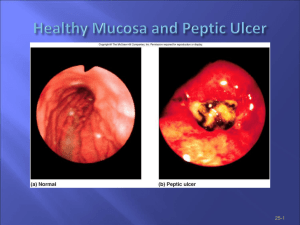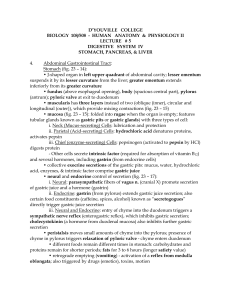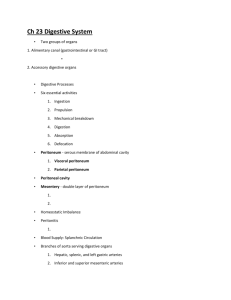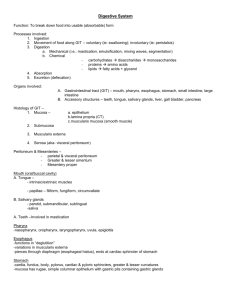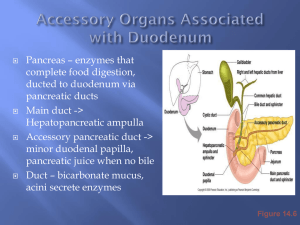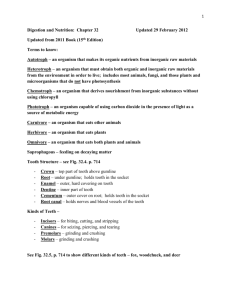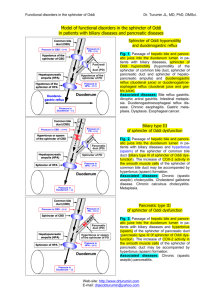The Digestive System
advertisement
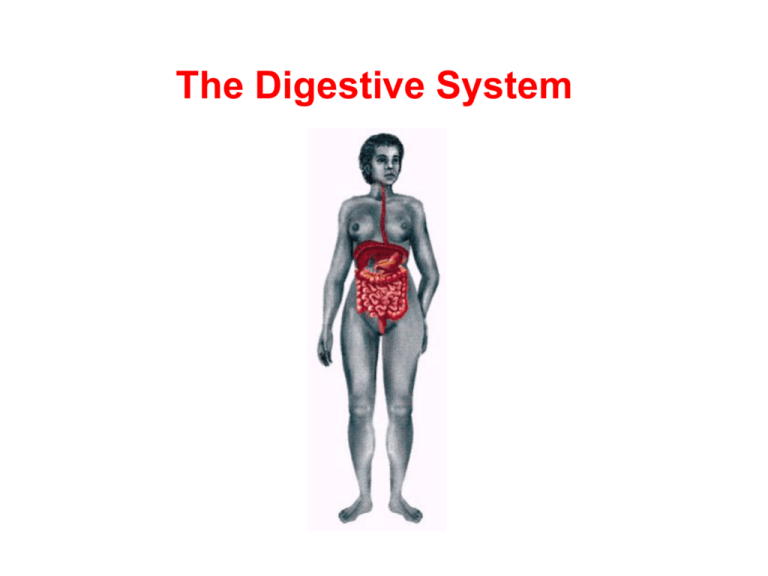
The Digestive System Processes of the Digestive System: Overview • Ingestion • Digestion: enzymatic • Motility • Secretion • Absorption • Elimination • (Self protection) Digestive Secretions/Abosrptions • • • • • • • • Salivary glands Pancreas Water Enzymes Mucus Ions: H+, K+, Na+ HCO3-, ClMass Balance (H2O) Figure 21-5: Daily mass balance in the digestive system The Organs of the Digestive System The Mouth The Salivary Glands The Esophagus The Stomach The Liver The Gallbladder The Pancreas The Small intestines The Large intestines The Mouth has the following functions : 1) breaking food 2) sense of taste 3) swallowing 4) speech Saliva and the Salivary Glands 1) moisten food and the mouth 2) clean the teeth, inhibit bacterial growth, 3) dissolve molecules so they can stimulate taste buds 4) digest a small amount of starch and fat Esophagus Esophagus The Stomach The Stomach Functions - food breakdown by gastric juices - host defense - minor role in absorption of nutrients Gastric pits mucous cells: produce The bottom mucus part of the pits is the gastric parietal cells:gland. produce HCl and intrinsic factor chief cells: produce pepsinogen G cells: produce hormones that regulate digestion The gastric glands produce 2-3 L of gastric juice daily, containing: pepsinogen HCl intrinsic factor Pepsinogen Contains the enzyme pepsin. Chop proteins into small fragments (amino acids) Pepsinogen Hydrochloric Acid Breaks down food and reduces pH of gastric juice to as low as 0.8. HCl Functions of HCl: (1) Helps activate pepsinogen. (2) breaks up connective tissues and plant cell walls. (3) destroys ingested pathogens. HCl Self protection of the stomach from HCl and pepsin by 1) a highly alkaline mucous coat. 2) rapid replacement of epithelial cells (3-6 d) 3) tight junctions between epithelial cells HCl Regulation of Gastric Function Gastric secretion and motility is divided into three stages: 1) Cephalic 2) Gastric 3) Intestinal phases 1) The Cephalic Phase The cephalic phase is stimulated by the sight, smell, taste, or mere thought of food. 2) The Gastric Phase - is stimulated by food in the stomach - accounts for two-thirds of gastric secretion. 3) The Intestinal Phase After entering small intestines, chyme inhibit gastric secretion via: a) the enterogastric reflex. b) local hormones The small intestine receives not only chyme from the stomach but also secretions from the liver and pancreas. The Liver has tremendous variety of functions, including the secretion of bile for digestive purposes. Hepatocytes secret bile into the bile canaliculi and bile ductules. bile ductule common Bile ductules hepatic ducts hepatic duct cystic duct common hepatic duct common bile duct gallbladder hepatopancreatic sphincter pancreas duodenum When no chyme is in the small intestine, the hepatopancreatic sphincter is closed. Bile flows into gallbladder. cystic duct common hepatic duct common bile duct gallbladder hepatopancreatic sphincter pancreas duodenum Function of Gallbladder: Absorbs water and stores the bile for later use. gallbladder hepatopancreatic sphincter duodenum Bile - is constantly produced by the liver (500-1,000 mL of bile per day). - is a yellow-green fluid containing : minerals bile pigments bile acids phospholipids cholesterol neutral fats facilitate fat digestion and absorption The Pancreas The Pancreas Exocrine: - secretes pancreatic juice into the lumen of the pancreatic duct Endocrine: - secretes insulin, glucagon, somatostatin into the blood. Exocrine secretes 1,200-1,500 mL of pancreatic juice per day into the main pancreatic duct. It empties into duodenum when hepatopancreatic sphincter opens. Pancreatic juice is an alkaline mixture containing: 1) sodium bicarbonate: neutralize HCl 2) Digestive enzymes which are secreted into the duodenum and digest carbohydrates, lipids, RNA, DNA, and proteins. Regulation of Bile and Pancreatic Secretion - secreted in response to similar stimuli. -Cephalic and Gastric phases The vagus nerves stimulate pancreatic secretion. The Intestinal Phase - Chyme with acid and fat, stimulate the duodenal mucosa to secrete cholecystokinin (CCK). 1) relaxation of the hepatopancreatic sphincter, 2) the contraction of the gallbladder 3) secretion of pancreatic juice and enzymes. The Intestinal Phase - Acidic chyme also stimulates the duodenum to release secretin. secretion of bicarbonate by both the hepatic and pancreatic ducts The Small Intestine Overview - Nearly all chemical digestion and nutrient absorption occur in the small intestines. 1) The duodenum - ~ 25 cm 2) The jejunum - comprises the next 2.5 m. 3) The ileum - forms the last 3.6 m. Small Intestine • Extends from stomach (pyloric sphincter) • Regions – Duodenum – Jejenum – Ileum Chemical Digestion and Absorption of Nutrients Carbohydrates Proteins Lipids Nucleic Acids Vitamins Minerals Water Small Intestine • Secretes digestive enzymes – Peptidases • Amino• Di• Tri- – – – – Sucrases Maltase Lactase Saccharidases • Di• Tri- – Lipase – Nucleases Small Intestine • Absorbs – – – – – 80% ingested water Electrolytes Vitamins Minerals Carbonates • Active/facilitated transport • Monosaccharides – Proteins • Di-/tripeptides • Amino acids – Lipids • Monoglycerides • Fatty acids The surface area inside the small intestine is greatly increased by circular folds called villi and microvilli. villi Figure 21-2e: ANATOMY SUMMARY: The Digestive System Structure of the Villi in the Small Intestine Absorption of Water - The digestive tract receives about 9 L of water per day 0.7 L in food 1.6 L in drink 6.7 L in gastrointestinal secretions - ~ 8 L absorbed by the small intestine via osmosis; Intestinal Motility serve three functions: 1) to mix chyme with intestinal juice, bile, and pancreatic juice (segmentation) 2) to churn chyme and bring it in contact with the brush border for digestion and absorption; (segmentation) 3) to move residue toward the large intestine. (peristalsis) - Segmentation is the most common type of movement of the small intestine. - When nutrients have been absorbed, segmentation slows and peristalsis begins. - The intensity of the contractions is modified by nervous and hormonal influences. The Large Intestine - No further chemical digestion - Water (~ 1L) is further absorbed. - The feces consists of: 75% water 25% solid matter, of which 30% is bacteria, and 30% undigested fiber. Bacterial Flora - refer to several species of useful bacteria in large intestine. - ferment cellulose and other undigested carbohydrates - synthesize B vitamins and vitamin K, which are absorbed by the colon. Strong contractions called mass movements occur one to three times a day, last about 15 minutes each, and occur especially an hour after breakfast. Neural Control of Defecation 1. Filling of the rectum 2. Reflex contraction of rectum & relaxation of internal anal sphincter 3. Voluntary relaxation of external sphincter Diarrhea too little water absorbed Constipation too much water absorbed, causing difficulty in defecation In the absence of bile, a fat-rich diet causes diarrhea. Accumulation of fat molecules osmolarity of intestinal content retain water diarrhea People lacking lactase have diarrhea after drinking milk. Lactose (a dimer) lactase glucose galactose People lacking lactase have diarrhea after drinking milk. Accumulation of Lactose osmolarity of intestinal content retain water diarrhea SUMMARY The Organs Digestion and Absorption of Nutrients The Stomach Carbohydrates The Liver Proteins The Gallbladder Lipids The Pancreas Nucleic Acids The Small intestine The Large intestine Vitamins Minerals Water

